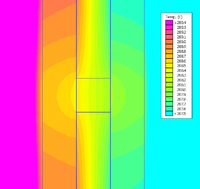
Photo from wikipedia
Because of thermal quenching, conventional luminescent materials suffer from severe problems when employed at high temperatures. Based on the thermally coupled energy levels (TCLs) of rare-earth ions, we report and… Click to show full abstract
Because of thermal quenching, conventional luminescent materials suffer from severe problems when employed at high temperatures. Based on the thermally coupled energy levels (TCLs) of rare-earth ions, we report and explain an abnormal thermal quenching phenomenon in the excited state of the charge transfer band (CTB), which is expected to bring out a solution to the problems of the low sensitivity of temperature-sensing materials and applications at high temperature. Temperature-dependent excitation spectra of Er3+ or Eu3+-doped CaMoO4, CaWO4, and LuVO4 phosphors are recorded. It was found that CTB exhibited two abnormal thermal quenching phenomena. One is that the intensity of the whole CTB increases with the rising temperature, named totally abnormal thermal quenching (TATQ), and the other is the integrated intensity decrease but the edge of the CTB at longer wavelengths enhanced with temperature, named edge abnormal thermal quenching (EATQ). The temperature-dependent excitation and diffuse reflectance spectra of the host and rare earth ions with moderate (Er3+) and large (Eu3+) energy separation between TCLs are investigated. One photodynamic model, considering influential factors, such as the absorption of the phosphor, energy transfer efficiency between CTB and dopants, and thermal coupling effect, is proposed and explains the unusual thermal response of CTB. Luminescence thermometry based on the abnormal thermal quenching is realized with the obtained relative sensitivity Sr of 4.65% K-1 @ 328 K, which is four times the value derived from the classic TCLs in the same phosphor.
Journal Title: Dalton transactions
Year Published: 2022
Link to full text (if available)
Share on Social Media: Sign Up to like & get
recommendations!